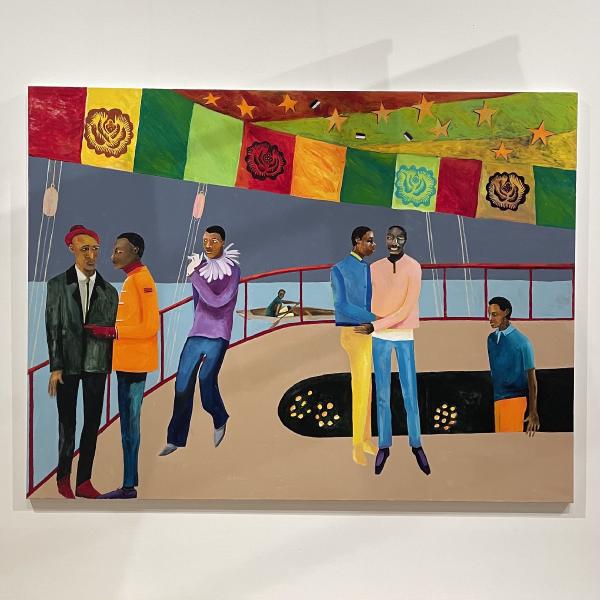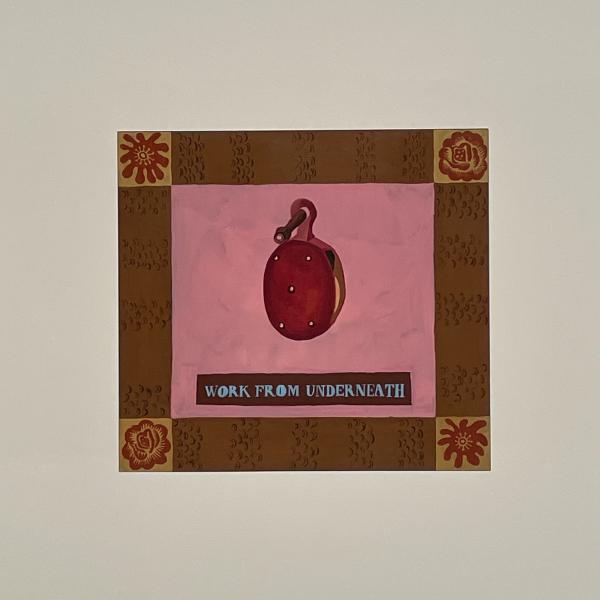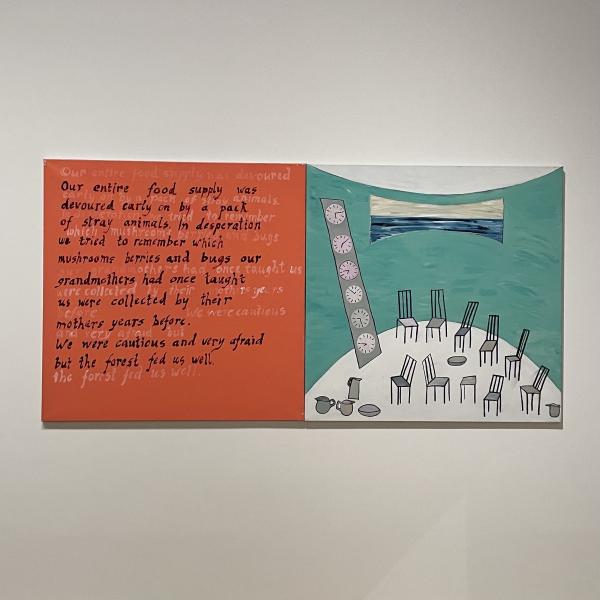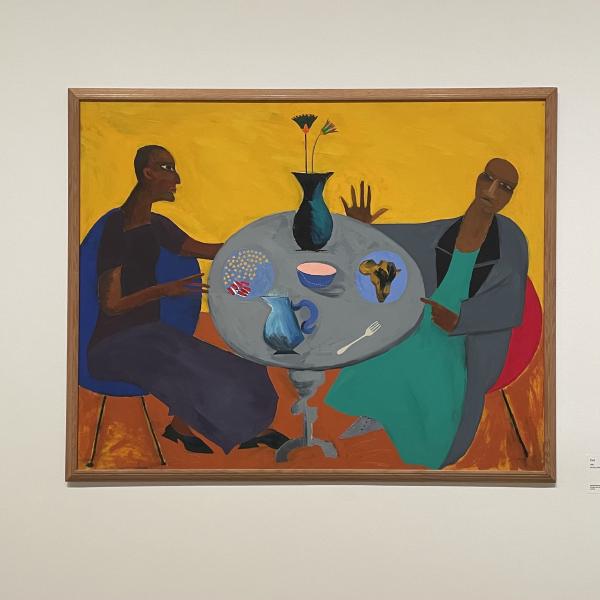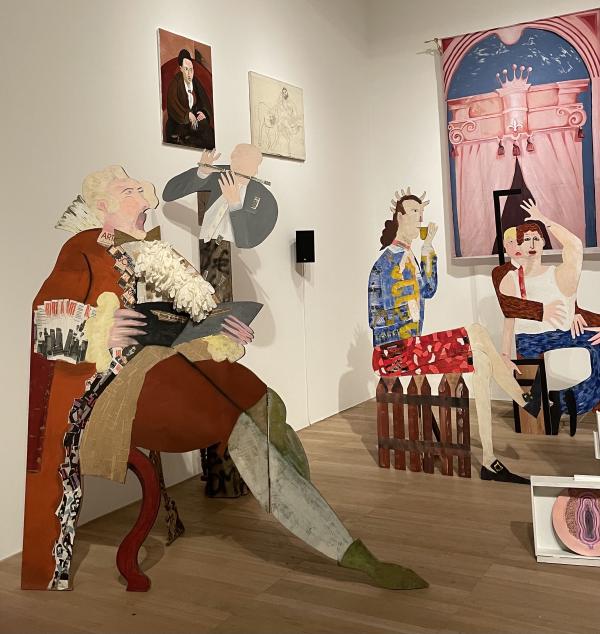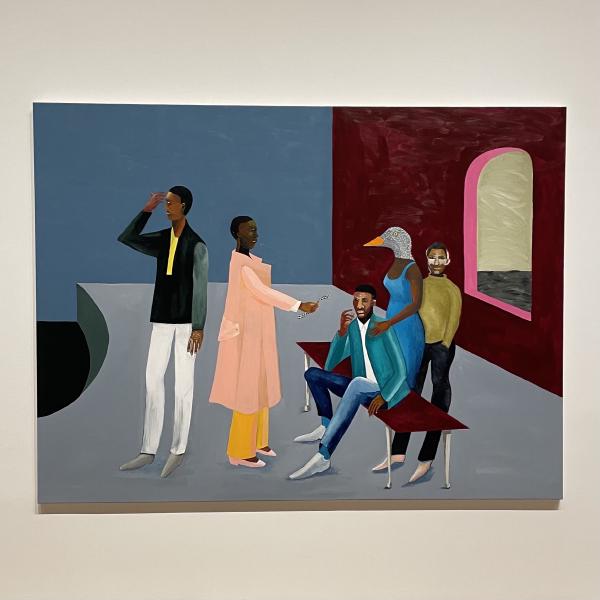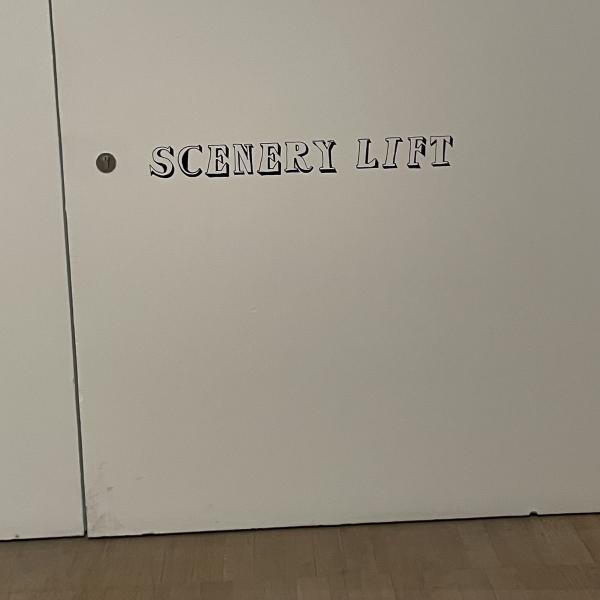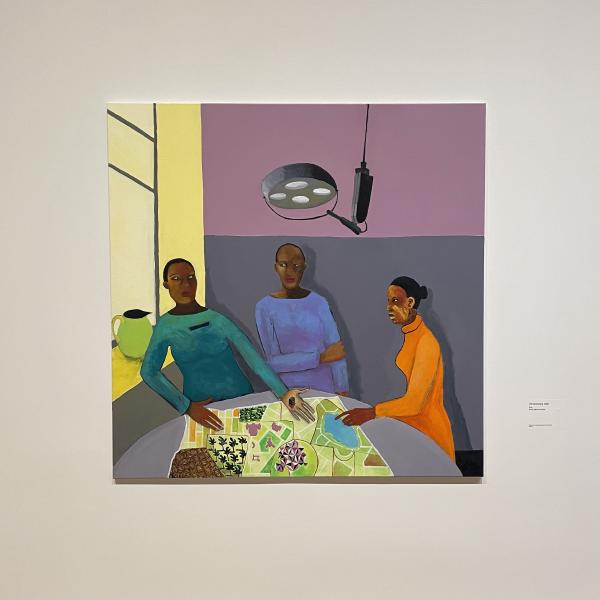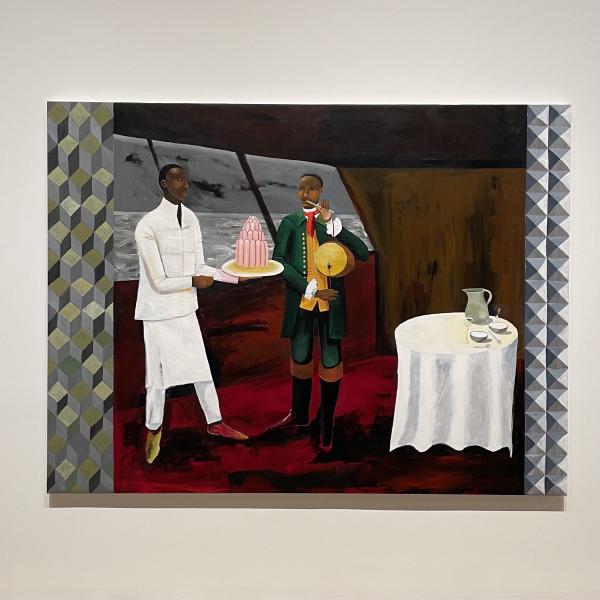Lubaina Himid @ Tate Modern
ZM
Emoji summary: 🌊❤️🔥📖
This is a review of Lubaina Himid’s show at Tate Modern. But this review is also about: good art, magic, dreams. And I love a good story. To be honest I’m not even discerning because I love a bad story too. I love the feeling of being transported to a new space, where you can swim around and simmer in a new atmosphere or mood. Even if it doesn’t belong to me, I love being on the inside of a heightened feeling.
We enter through a little hallway room that’s painted deep magenta. It feels like the inside of a mouth, a liminal space to pass through, be spat out of. Way up above my eyeline words trail round the corner: OUR KISSES ARE PETALS OUR TONGUES CARESS THE BLOOM. These wall texts run through the gallery, like annotations or heckles. They pop up like a narrator to remind you: Something’s Happening.
First: little square paintings. A neat and tidy formula of image and caption, like a kid’s picture book. An orange work glove; ENSURE SUFFICIENT SLACK. A hammer; ACCOMMODATE THE LARGEST USERS. A handsaw with a yellow handle; ALLOW FOR SHORT BREAKS. A red pulley joint; WORK FROM UNDERNEATH. The images are all things you’d find in a toolbox, the captions are all written as definitive instruction. GIVE WARNING OF UNDUE STRAINS. Health and safety is a kind of socialist policy because it foregrounds the wellbeing of workers, a kid’s handbook for labour relations, a wikihow guide for unionising - it makes me laugh, but the punchline is bottomless. I think a handbook like that would be really useful and powerful, but sincerity always makes me cringe a bit. It is softer if we hedge our bets and just call it art, like that’s a way of zooming out from intention.
The gallery rooms are huge but sound wraps around the spaces and draws you close. I got here a bit before 10am, had to queue up outside to wait for them to open the sliding doors for me like a keen bean. So as I walk round, it’s me and like 7 other neeky and enthused morning people with fresh faces and lots of space. It could feel all empty around me, like the big rooms were baggy, an oversized fit slipping down over my hips. Audio fills the dead space. One room is an immersive full room work by Lubaina and Magda Stawarska-Beavan, Blue Grid Test. A blue line, patterned and chunky, zooms off around the walls of the gallery. Like a wallpaper strip, it’s painted over this assemblage: disembodied piano lid, cardboard box, framed newspaper front page, sideways banjo, bed headboard. A voice repeats different blues in different languages over and over itself. BLUE BLAU AZURE BLEUX ULTRAMARINE COBALT INDIGO MIDNACHT BLAU CERULEAN PRUSSIAN BLUE. This room feels like a swimming pool. Even more so with the echoing blues, voices bouncing off tile. Because of them, I don’t feel lonely or cold or small.
The bit I want to react to is the main room, where the paintings get bigger and start properly, in earnest. A baby runs past me through the gallery and the slap of tiny soft feet on the floor pulls a thought out: the common medium is not paint or subject, but story itself. Story™️. I am racing through the rooms, over pages to find out what happens next. I am on the inside of something as it moves.
Double paintings, hung two by two and side by side, like facing pages in a book. One side with images, one side with text - again. One spread has the text on a perfect orange page, with a pink shadow of the letters underneath each line. I can’t figure out a consistent narrative through the pairs, but they relay a first person account. The orange one: ‘Our entire food supply was devoured early on by a pack of stray animals. In desperation we tried to remember which mushrooms berries and bugs our grandmothers had once taught us were collected by their mothers years before. We were cautious and very afraid but the forest fed us well.’ On the other page there’s an empty circular room with peppermint blue walls curving tightly round. Some empty chairs with spindly legs and backs are scattered across the curved space, a collection of jugs and a row of clocks on a board. In the middle of the curved wall, there’s a wide window looking out onto the sea. The painting is all smooth colour, flat and matte and drawn like perspective is an inconvenience. But the sea is feathery and choppy, with these fat strokes gliding across.
I head deeper. The images start splintering and fragmenting in front of me. Story becomes more prominent as a mechanism. On one page, two images run parallel in separated strips. Vignettes, windows, split screen display - the paintings’ aspect ratio changes and the text within the images disappears. More, more, more, and it becomes kinda meta? A painting of two people in a theatre box. Red velvet sashes swoop under the plush balcony, they look out away from us on to an empty stage. We are watching them watch the stage and wait, all of us anticipating and all of us apart from each other. I want to READ these images. The text is gone but story is still under their skin in symbol and gesture. I’m limber to receive it all, warmed up and raring to go. Next one. Yellow background, a woman in a grey duster coat points a stubby finger towards Africa on a plate. Her dining companion looks back at her, reaches out over a plate of stars and sushi. They are both wearing court shoes, a vase of two flowers between them. The narrator is on the wall behind me with more chunky text, prompting me with questions like I’m in the middle of a critical reader edition: WHAT IS THE STRATEGY?
Ah, idk! Can images have whimsy? Can they ~be~ whimsical? I don’t know if that’s a quality they can take on. The paintings are surreal and dreamy in the way stories often are, but there is a sparseness, stillness and style that I don’t quite know how to pin down. I don’t know what words to use, other than to say: a loose grip on the hand of reality, dream space, fiction, sugar high from cherry coke. Not whimsy (like twee kitschy over embellishment) but Whimsy (like a release from the confines of expectation, indulgence of playfulness, fun). Because maybe painting conventions have been too hung up on formalities: White Europe is abstract, form, image as critical attempt to unpick the human condition. And I’m speaking in huge sweeping terms, full of inaccuracies. But here, image is a kind of portal you can disappear through. Yeah, like fantasy, like you’re in possession of magic. My eyes stick to these paintings. I want to test their tension. I want to touch them and see if their surface will give way and allow me entrance to a different space; a beyond. Lubaina makes images that are a vehicle rather than a still container, they’re transportive. Like Chagall with LEGS: not a limp dream you remember when you wake, but a firm lucid insistence while you’re still asleep within it.
Further in, again. There’s a tableau stage setup: a work called A Fashionable Marriage. Cutout figures propped up and staggered to build a scene, a densely stacked crowd. It’s mixed company, jumbled in together: a Black woman in a black shoulderless ball gown, a couple regency era looking white guys, all dandy in their short trousers and tights. Looking like a Hogarth drawing with bouncy wigs all pasty, faces like deli counter cold meats and cheese. They look like if a continental breakfast was a person. There’s a Margaret Thatcher cutout, with the face splintered and I want to hiss like she’s a panto villain. The crowd yells: maggie maggie maggie out out out. A pink stage background castle on a canvas behind, a reminder. Politics is a kind of pantomime too. We can make it real; make politics a scene, an arrangement of figures and bodies, make the city a space between us. A stage is only the limit we place down around ourselves; it’s just Westminster, London, the news. Maybe I want to enter the space of these works because they are so still. I am not audience, spectator, viewer. I’m delusional and I think they are waiting for me to join them so they can begin the scene. I have to get up past the barrier and stand amongst them, yell ‘ACTION!’ so I can commune and pass through.
The wall text pushes us through to the next chapter: WHAT HAPPENS NEXT? Big paintings loom on the walls, solitary and proud. I am ready for the images to hit me one after the other, waves cresting and breaking, wind down shore.
Three women sit at a table looking over a map. The map is colourful: green and blue patches, shrubbery and housing blocks. There’s a surgical lamp hovering over their heads and they gesture and point at different bits of territory. Next painting. A woman stands in front of a stove. She is front and centre, her flat body is turned looking off to the side. Her hands cradle a small bird with red brown white black and yellow markings. I want to call it a partridge but I’m from London, so I don’t really know any birds. It has a pointed tail and it is quiet and still. Her dress is a flat grey that absorbs the eye in its powerful uniformity. Two people stand at a window, facing away from us, waving at something or someone we can’t see. Next painting. A woman cuts 11 lemons on a counter, the sea behind her is bluey green. One of the lemons has been painted on a little block and added to the bottom like a post it. The title is SLICE TEN LEMONS. I wonder if I’ve miscounted so I count again, but there are 11. I laugh aloud in the quiet gallery. She is wearing medals on her chest, and a paper christmas cracker crown.
And honestly I’m never ready to talk about how the paint is laid down and how it’s all composed. It’s just flat matte paint. If I make my eyes go out of focus, the images stay the same: fields of colour in solid shapes. They are sturdy, absolute. Like they’ve been decided before they even existed, like they came into being fully formed with no need for consideration or adjustment. Just ready to go. They do not beg questions, they only tell you something. They are deliberate, everything that’s in them feels like a sign.
Now is as good a time as any to remind you of something I should have mentioned at the beginning. Lubaina Himid studied theatre design back in the 70s, came into art already thinking about the gallery as an affective space, theatrical forum, host. Story, stage, fiction, dramatic twist. Because of all of these things, the paintings take on the quality of an image conjured in a dream. They are dream space, theatre, where your front mind is taking a back seat to the subconscious drive of Something Else. I walk around and just kind of accept the dynamic, influx of symbol, story, meaning and magic. Someone hovers on chaise longe, woman with bird head, regency gentleman in livery plays a bizarre instrument while being handed a pink layered jelly by a chef in white. The sea storms away in the background of almost all these paintings like it is an ancient witness, Homer’s wine dark sea, erotic body, our eternal mother. It is grey and blue and baby blue and murky green and black. Wine dark wine dark. I wonder what it means, if it’s a symbol or a sign or a literary device. And I wonder where the images come from, but I don’t want to ask or try to find out because honestly I don’t want to know. I don’t want to question it all because I worry that an answer will puncture the skin of this mythic power. Allegories don’t need explanation because they are explanation in and of themselves.
Then everything becomes small and close. The last room is almost empty. There are speakers and a structure off at the end. Music booms out, singing in chorus, like a crowd or a choir. The structure is a bike shed, white and empty. On the back rail: DO YOU WANT AN EASY LIFE is written in red. It looks like it’s written in blood, spooky and sparse, haunting. The music changes to sad violins. A woman speaks, names herself, ‘I USED TO LIVE ON HILLTOPS’. More people voicing their own stories. Because it is fundamentally a tool of empathy. When you tell someone a story about yourself or about the world as you see it, what you’re really doing is connecting the space between you, charging it with an energetic link. Even in this room with a minimalist installation that feels miles away from what we’ve just seen, there is a theatrical thread linking through it all. Story story story is the medium the connective tissue.
On my way out through the gift shop, I stop and think for a moment. I have felt something rare and precious. I want to write a love letter to these paintings. And I could! I could write a collection of stories about the quiet, dignified worlds contained in each and every one. I stop and double back so I can buy a postcard. For the first time in like… 9 years? I want something to take home with me. I want a souvenir. I want a little handheld portal so some of the rare magic could be my own.
Lubaina Himid’s show is on at Tate Modern until 3rd July, more info here.
Pls also don’t forget: i still hate Tate, i j cba to let that leak into a review of a show i rly liked/an artist i rly wanted to write about uninterrupted :)
